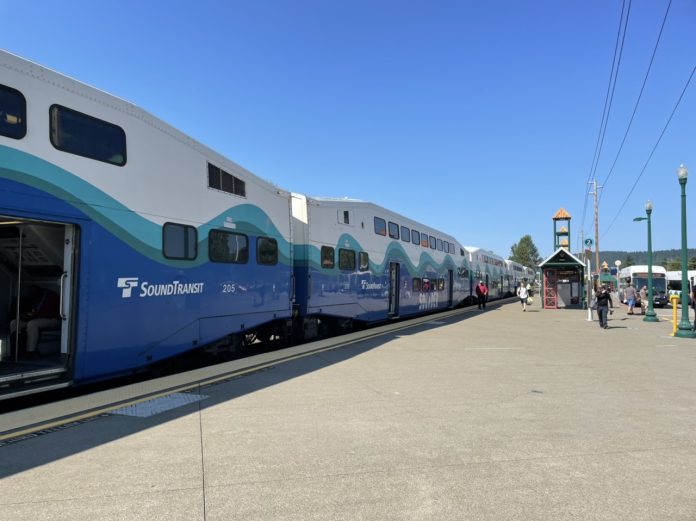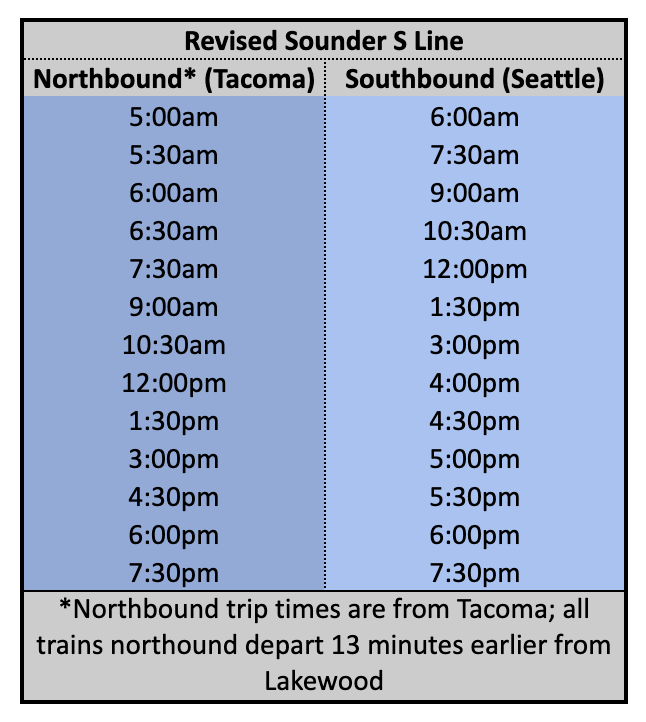Ridership on Sounder’s southern line has taken a huge hit since the pandemic started in 2020. Sound Transit moved to cut service down to the bone for a time on the S Line, which runs between Seattle and Lakewood. That likely depressed ridership even more than it otherwise would have been, but in the past year trips have been restored and ridership has slowly been building back. Still, the S Line is only at about 28% of pre-pandemic ridership as office workers continue to choose to stay home in droves.
Perhaps it’s time to rethink the line’s strategic plan and how service is being deployed so that it operates as an all-day service instead of being so heavily focused on peak commuting hours. Doing so could open the window to other possibilities down the line.
What’s the problem with Sounder?
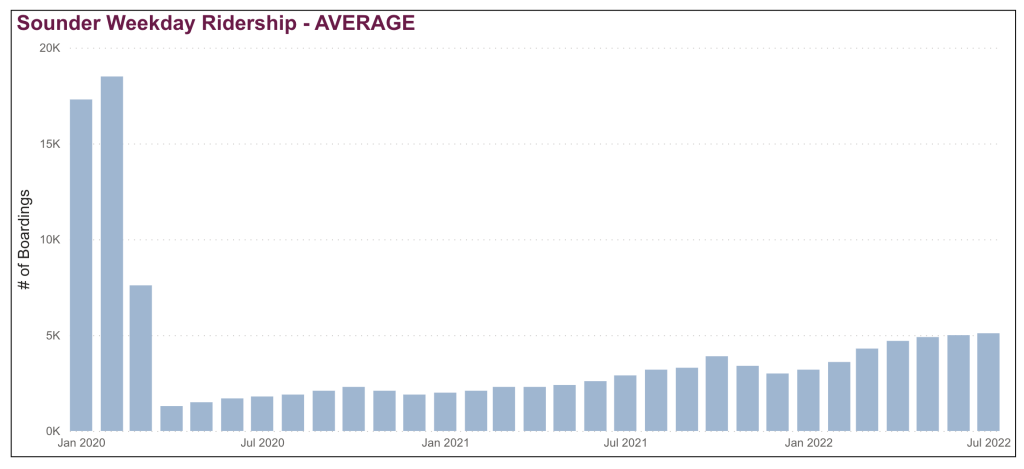
Looking at the data, ridership levels for the Sounder network are fairly grim. Sound Transit reports that the network has been averaging about 5,000 daily riders in recent months. That’s a far cry from the average of 17,900 daily riders in 2019. On the S Line, average weekday ridership per train trip ranged 53 to 363 riders with an overall average of 211 riders per trip in August. There is some further variability that isn’t captured here given that office worker habits tend to be more midweek these days, but trains aren’t close to seated capacity. Overall, trends show that the ridership rebound on the Sounder network has mostly plateaued over the summer months. There is hope that could change a bit as more employers call workers back to the office and higher education institutions go back into session.
However, this situation isn’t exactly unique among commuter and regional rail operators. Philadelphia’s Regional Rail network, for instance, has only rebounded to about 39% of pre-pandemic ridership. And Chicago’s Metra rail network was at about 40% of pre-pandemic levels in July.
It could be the case that significantly reduced peak-oriented ridership is here to stay for commuter rail service, which really begs the question of if Sound Transit should keep the existing paradigm or try something new. That’s an especially important question to answer because the agency has a $1 billion capital program planned for the southern Sounder corridor through 2046.
What’s in the S Line’s strategic plan and how it could be refined?
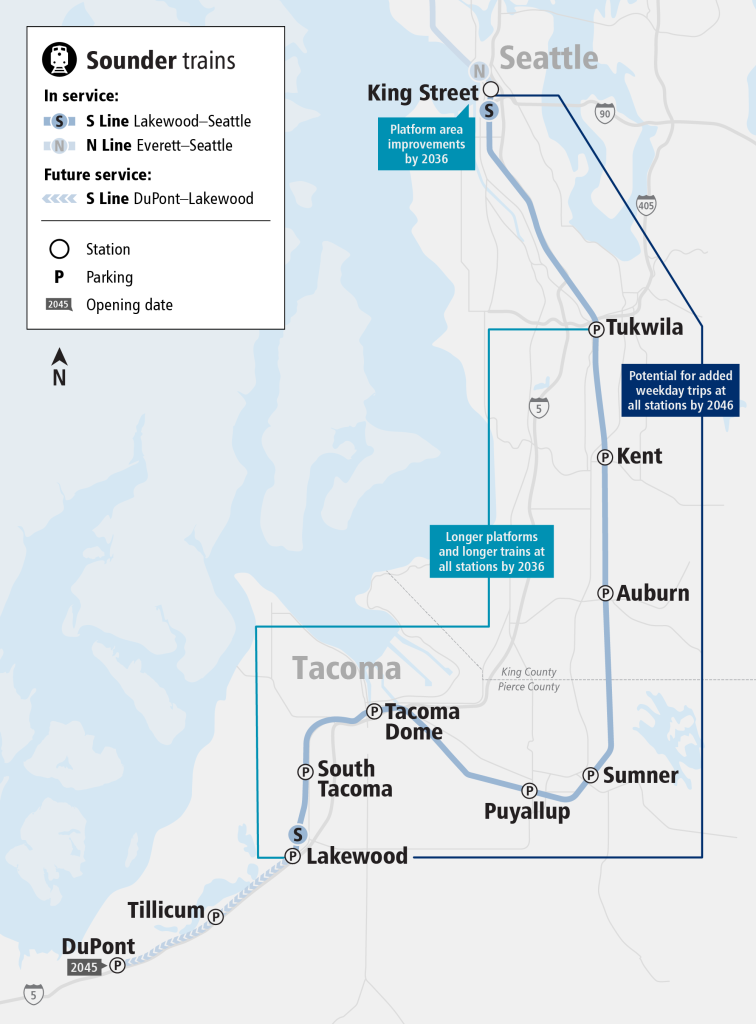
A strategic plan for the southern corridor was developed prior to the pandemic and finalized just as it was taking off. It was devised based upon ridership realities at that time, calling for longer trains and adding more trips in peak commuting periods. Specifically, the strategic plan recommended extending station platforms to accommodate up to 10-car trains, purchasing additional coaches, expanding storage and maintenance space, and making investments and agreements to facilitate more peak-hour trips with frequencies in the 15- to 20-minute range.
If peak travel demand by office workers is lower per capita going forward, this strategy could be a decidedly poor one that creates the wrong capacity but nets very little additional ridership to fill it.
Sound Transit might be better off making better targeted investments by purchasing additional trips throughout weekdays and weekends while forgoing platform expansions and most of the additional coach purchases and reducing how much additional storage and maintenance space might be needed for equipment. Focusing on capacity by increasing and spreading trips throughout the daytime and targeted track improvements along BNSF’s corridor could ultimately prove successful by generating all-day travel demand and better utilizing the existing fleet — which is heavily wasted by one-way deadhead trips right now. The agency might also be wise to skip out on further parking lot expansions and even redevelop lots with transit-oriented mixed-use.
Additionally, there is some overlap with the strategic plan and planned DuPont extension — a separate but related Sounder S Line project (pegged at about $325 million). The extension will add two stations south of Lakewood at Tillicum and DuPont to the S Line network and expand service. Originally planned for an opening in 2036, the project now isn’t due for delivery until 2045. However, it might be able to be moved forward with very low-cost station facility strategies.
What could be an interim strategy?
Recently, The Urbanist discussed how Puget Sound needs a regional rail network — a network with frequent, all-day, everyday regional passenger rail services from Stanwood to Olympia and deeper into the suburbs. We’re still a long way off from that vision, but the ridership challenges that Sounder faces could present an opportunity to reimagine the S Line now, transforming it from commuter service to regional rail service on weekdays without even adding new trips. By doing this, Sound Transit could test out this new paradigm and eventually build out the corridor for even more frequent, reliable service and adding in weekend service.
So let’s run through how the schedule could be restructured.
As a baseline, Sounder S Line service could be designed to have a modest window of more frequent peak-hour periods in the morning and afternoon and then semi-infrequent off-peak service on weekdays, spreading out trips throughout the day by moving underutilized peak-hour slots to other time periods. Peak-hour service in peak-demand directions could see a series of half-hourly frequencies with off-peak service usually running about every 60 to 90 minutes. In both directions, service could run from about the 5:00am/6:00am period to about the 7:30pm period (at least in terms of departures from Seattle and Tacoma).
Additionally, all trips could operate to and from Lakewood, which is currently the furthest south Sounder station (not all trips serve it today). A limited amount of additional sidings may be required to address occasional off-schedule situations that otherwise could constrain the northern half of the Point Defiance Bypass.
Here’s what that could look like:
Service on the S Line could be even better if and when Amtrak Cascades service allows for Rail Plus on the corridor. That program allows for Sound Transit riders to use their ORCA cards to purchase tickets on Cascades and ride between stations served by both Cascades and Sounder. Currently the program only applies to the Sounder N Line corridor, allowing for travel between King Street, Edmonds, and Everett Stations. If it were expanded to the S Line, riders could benefit from Cascades trips between King Street, Tukwila, and Tacoma Dome Stations. By and large, that would be a boon to Seattle-Tacoma riders because Cascades is 17 minutes faster than Sounder. It would also begin to fill out the schedule and may add credence to the idea of introducing a Cascades stop in Auburn, as suggested in our regional rail story.
Right now, there are only three daily Cascades trips between Seattle and Portland, but the Washington State Department of Transportation (WSDOT) — which supports the service — has said that they still plan to restore service to four daily roundtrips and there have been long-standing plans to increase service to six daily roundtrips. Because of a fatal derailment several years ago, Cascades is running Horizon trainsets right now, but the corridor is set to get an upgrade to modern and higher-capacity Venture trainsets in 2025 or 2026.
Here’s what the schedule could look like if Cascades trips were designed to align with Sounder service and facilitate Rail Plus:
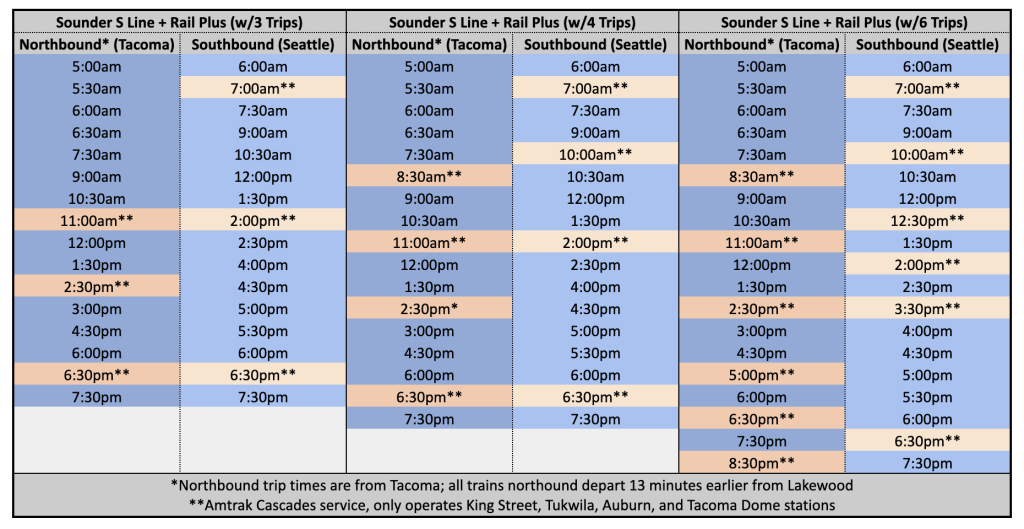
These conceptual schedules really show the combined power of blended Sounder and Cascades service on the S Line corridor. Giving riders more choice on fast rail service between Seattle, South King, and Pierce County communities could wind up being a big success and it could get the region to begin rethinking the longer-distance transit strategy. That strategy could eventually morph into elevating the priority of regional rail investments.
If you support this concept or elements of it, contact Sound Transit and the Sound Transit board of directors to let them know.
Stephen is a professional urban planner in Puget Sound with a passion for sustainable, livable, and diverse cities. He is especially interested in how policies, regulations, and programs can promote positive outcomes for communities. With stints in great cities like Bellingham and Cork, Stephen currently lives in Seattle. He primarily covers land use and transportation issues and has been with The Urbanist since 2014.

